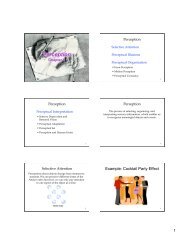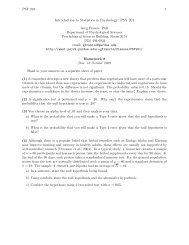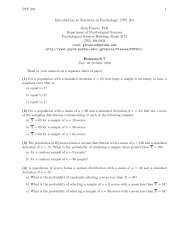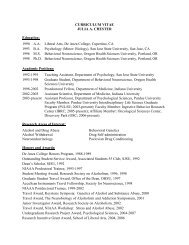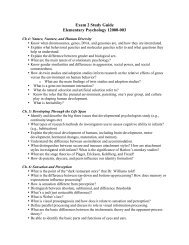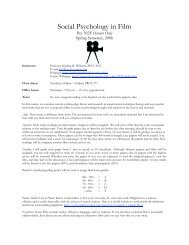Maxims or Myths of Beauty? A Meta-Analytic and Theoretical Review
Maxims or Myths of Beauty? A Meta-Analytic and Theoretical Review
Maxims or Myths of Beauty? A Meta-Analytic and Theoretical Review
You also want an ePaper? Increase the reach of your titles
YUMPU automatically turns print PDFs into web optimized ePapers that Google loves.
392 LANGLOIS ET AL.<br />
Barber, 1995; Berscheid & Walster, 1974; Buss, 1998, 1999; Buss<br />
& Schmitt, 1993; Cunningham, Druen, & Barbee, 1997; Eagly et<br />
al., 1991; Feingold, 1992a; L. A. Jackson, 1992; D. Jones, 1996;<br />
Kalick, Zebrowitz, Langlois, & Johnson, 1998; Langlois, 1986;<br />
Langlois & Roggman, 1990; Zebrowitz, 1997). Although some<br />
aspects <strong>of</strong> these predictions have been evaluated by previous<br />
research, many imp<strong>or</strong>tant pieces <strong>of</strong> the the<strong>or</strong>ies have not yet been<br />
addressed. Table 1 provides a list <strong>of</strong> predictions suggested by the<br />
different the<strong>or</strong>ies that we elab<strong>or</strong>ate on below.<br />
Although we present them separately f<strong>or</strong> purposes <strong>of</strong> clear<br />
exposition, we do not believe that any one the<strong>or</strong>y <strong>or</strong> mechanism<br />
operates to the exclusion <strong>of</strong> the others. F<strong>or</strong> example, within fitness-<br />
related evolutionary the<strong>or</strong>y, several different evolutionary mecha-<br />
nisms are relevant, are not necessarily mutually exclusive, <strong>and</strong><br />
may be operating simultaneously (Gangestad & Th<strong>or</strong>nhiU, 1997;<br />
Kirkpatrick, 1996). The usefulness <strong>of</strong> the systematic, modular<br />
approach we take here is in beginning to paint a m<strong>or</strong>e constrained<br />
picture <strong>of</strong> the domains, conditions, <strong>and</strong> developmental traject<strong>or</strong>ies<br />
<strong>of</strong> the relevant evolutionary <strong>and</strong> social mechanisms <strong>and</strong> in under-<br />
st<strong>and</strong>ing where they do <strong>and</strong> do not intersect.<br />
Socialization~Social Expectancy The<strong>or</strong>ies<br />
Two c<strong>or</strong>e assumptions underlie socialization <strong>and</strong> social expect-<br />
ancy the<strong>or</strong>ies: (a) Cultural n<strong>or</strong>ms <strong>and</strong> experiences influence the<br />
behavi<strong>or</strong> <strong>of</strong> both targets <strong>and</strong> perceivers, <strong>and</strong> (b) social stereotypes<br />
create their own reality (see, e.g., Langlois, 1986; Snyder et al.,<br />
1977). These c<strong>or</strong>e assumptions map on to the three maxims about<br />
attractiveness. Acc<strong>or</strong>ding to the first assumption, people should<br />
agree about who is <strong>and</strong> is not attractive within cultures because <strong>of</strong><br />
cultural similarities in st<strong>and</strong>ards <strong>of</strong> attractiveness. In contrast, the<br />
the<strong>or</strong>ies predict lack <strong>of</strong> agreement in cross-cultural judgments <strong>of</strong><br />
attractiveness because different cultures have different cultural<br />
st<strong>and</strong>ards <strong>of</strong> beauty (Darwin, 1871; F<strong>or</strong>d & Beach, 1951). We<br />
evaluate agreement about target attractiveness both within <strong>and</strong><br />
across cultures in our first set <strong>of</strong> meta-analyses (reliability).<br />
Social stereotypes create their own reality through a multistep<br />
causal mechanism: (a) Facial appearance elicits social stereotypes<br />
<strong>or</strong> expectations f<strong>or</strong> the behavi<strong>or</strong> <strong>and</strong> traits <strong>of</strong> attractive <strong>and</strong> unat-<br />
tractive targets, (b) these expectations are acted on by the perceiver<br />
in the f<strong>or</strong>m <strong>of</strong> differential judgments <strong>and</strong> treatment <strong>of</strong> attractive<br />
<strong>and</strong> unattractive targets, (c) differential judgment <strong>and</strong> treatment<br />
cause the development <strong>of</strong> differential behavi<strong>or</strong> <strong>and</strong> traits in attrac-<br />
tive <strong>and</strong> unattractive targets, <strong>and</strong> (d) attractive <strong>and</strong> unattractive<br />
targets internalize differential judgment <strong>and</strong> treatment <strong>and</strong> even-<br />
tually develop differential behavi<strong>or</strong> <strong>and</strong> self-views (f<strong>or</strong> detailed<br />
discussions, see Darley & Fazio, 1980; <strong>and</strong> Zebrowitz, 1997).<br />
The stranger-attribution literature <strong>and</strong> meta-analyses <strong>of</strong> it have<br />
f'Lrmly established the existence <strong>of</strong> the "beauty is good" stereotype<br />
(see, e.g., Adams & Crane, 1980; Berscheid & Walster, 1974;<br />
Dion, 1973; Downs & Harrison, 1985; Eagly et al., 1991; Fein-<br />
gold, 1992b; Langlois, 1986; Ritter, Casey, & Langlois, 1991;<br />
Snyder, Berscheid, & Glick, 1985). At least among strangers,<br />
attractiveness clearly elicits differential expectations f<strong>or</strong> the be-<br />
havi<strong>or</strong> <strong>and</strong> traits <strong>of</strong> attractive <strong>and</strong> unattractive targets. In our<br />
second set <strong>of</strong> meta-analyses (judgments), we examine studies in<br />
Table 1<br />
Predictions Derived From Social Expectancy <strong>and</strong> Fitness-Related Evolutionary The<strong>or</strong>ies<br />
Prediction Social Mate selection<br />
The<strong>or</strong>y<br />
Good<br />
genes<br />
Differential<br />
parental solicitude<br />
Reliability <strong>of</strong> judgments<br />
Within-culture agreement Yes Yes Yes Yes<br />
Across-culture agreement No Yes Yes Yes<br />
Gender differences Yes Yes No No<br />
Age differences Yes NCP No NCP<br />
Judgment <strong>and</strong> treatment<br />
Differential judgment Yes Yes f<strong>or</strong> adults Yes Yes f<strong>or</strong> children<br />
Gender differences Yes Yes f<strong>or</strong> adults No No<br />
Age differences Yes NCP No NCP<br />
Differential treatment Yes Yes f<strong>or</strong> adults Yes Yes f<strong>or</strong> children<br />
Gender differences Yes Yes f<strong>or</strong> adults No No<br />
Behavi<strong>or</strong>/trait differences Yes Yes f<strong>or</strong> adults Yes Yes<br />
Attractiveness is honest indicat<strong>or</strong> <strong>of</strong> No Yes f<strong>or</strong> women Yes Yes<br />
fitness<br />
Gender differences Yes No No No<br />
Age differences Yes NCP No NCP<br />
Differential self-perceptions Yes NCP NCP NCP<br />
Gender differences Yes No No No<br />
Age differences Yes NCP No NCP<br />
Causality<br />
Judgment/treatment causes behavi<strong>or</strong>al/ Yes No No No<br />
trait differences<br />
Behavi<strong>or</strong>s/traits cause judgment <strong>and</strong> No Yes Yes Yes<br />
treatment<br />
Note. NCP = no clear prediction.





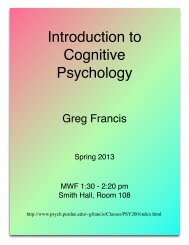
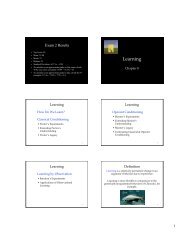
![Exam 4 Study Guide[1]](https://img.yumpu.com/45196739/1/190x245/exam-4-study-guide1.jpg?quality=85)
